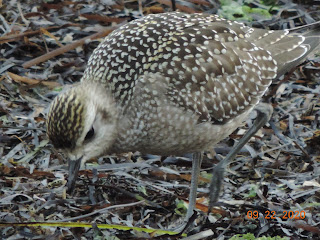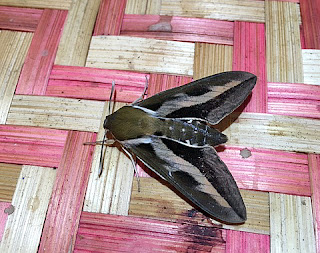NATURE
MONCTON INFORMATION LINE, September 23, 2020 (Wednesday)
To respond by e-mail, please address
your message to the information line editor, nelsonpoirier435@gmail.com .
Please advise the editor at nelsonpoirier435@gmail.com if any
errors are noted in wording or photo labelling.
For more information on Nature Moncton, check the website at www.naturemoncton.com .
Edited by: Nelson Poirier nelsonpoirier435@gmail.com
Transcript by: Brian Stone bjpstone@gmail.com
Info Line # 506-384-6397 (384-NEWS)
** Aldo Dorio got a superb photo of an AMERICAN
GOLDEN-PLOVER [Pluvier bronzé] from a side view that nicely shows that longer
primary projection than the Black-bellied Plover. I am going to add Gilles
Belliveau’s helpful comments as it is easy to confuse the juvenile versions of the Black-bellied and American Golden-Plover (at least in the editor's eyes).
Gilles comments that this Plover looks
like an American Golden Plover. The bill looks a bit short and more slender
than he would expect on a Black-bellied Plover, the primary projection seems
long, it has a fairly dark auricular, and the cap appears fairly dark with a
moderately prominent supercillium. Also the blurry, grayish brown markings on
the underparts seem to go all the way down onto the belly rather than being
mostly on the chest, but this is less useful as some Black-bellied Plovers also
have this though most have fairly white bellies.
Aldo also photographed a juvenile RUDDY
TURNSTONE [Tournepierre à collier] showing the juvenile scaled feather plumage.
** Rheal Vienneau came across an adult
BEDSTRAW HAWK-MOTH, aka GALIUM SPHINX MOTH in his Dieppe greenhouse on Tuesday
morning. This is surely a very late bloomer as this is the time of year that we
can expect to see the plump caterpillars moving about ready to cocoon for the
winter.
**During
Wednesday’s rain, Marguerite Winsor had 3 EASTERN BLUEBIRDS visiting the roof
of their neighbour’s house across the street in Salisbury and also perching on
the power line. She was able to take
some photos, one of them with a Chipping Sparrow.
Marquerite
and Bill’s big treat was Tuesday on their return from a weekend in St. George
when they saw 55 wild TURKEYS in 4 different flocks in the area of Upper Waweig
Road.
In
the group photo, they we had stopped by the side of the road and that group of
wild Turkeys kept coming toward their car on the side of the road. They ran
into the woods when a vehicle came by. They counted themselves very lucky!
Marquerite
was also able to photograph one lone wild Turkey in someone’s yard after the
rest of the flock had flown away.
** The Cape Jourimain Nature Center is
sponsoring an Eco Conference virtually this coming Thursday and Friday,
September 24th and 25th. I am attaching the information
below to register for those who wish to participate. I apologize for the late
notice but was not advised of it earlier. Note that in the registration one has
to register for each day separately and there is no fee. This will be available
for viewing at some time after the event so if you register promptly and can’t
make it for the time of delivery you can get it later. This form of attending
presentations has become popular to meet Covid restrictions and has turned out
to be a great way to share information. I was able to listen to the webinar
that Dorothy Diamond gave on sparrows recently and it was a very rewarding
experience. I have registered for the Cape Jourimain event and look forward to
participating later to not miss some great sounding presentations. Check out
the notice and registration information below.
Join us Thursday, September 24 and Friday,
September 25 for our special online Eco Conference.
Register online at: https://www.capejourimain.ca/events/eco-conference
Thursday
1PM - Conservation, Stewardship, and Engagement in
New Brunswick
By Nature Trust of New Brunswick
2PM - Monitoring Monarchs and Milkweed in NB
By Nature NB
3PM— Climate
Change in the Acadian Forest
By Community
Forests International
Friday
9AM— The Motus Wildlife Tracking System
By Birds Canada
10AM - Watershed Management: Local Monitoring and
Solutions
By Petitcodiac Watershed Alliance
11AM— Water Quality Monitoring in the Cape
Tormentine Peninsula Watershed
By EOS Eco-Energy
** Anna Tucker watched and photographed
a group of HOUSE SPARROWS [Moineau domestique] in bushes in front of the
Central United Church on Church St. in Moncton on Saturday morning. This
introduced sparrow species has decreased dramatically in number in New
Brunswick which in one way is a blessing in disguise for the many cavity
nesting native species which the House Sparrow can outcompete. It is apparent
in some of Anna’s photos that there are young-of-the-year birds present.
** We have gotten a bit more involved
than we had intended on some submitted LADIES’-TRESSES ORCHID photos that have
been sent in but we have not posted as we were having challenges getting them
identified by lack of responses from Orchid experts who are much more
knowledgeable on late season Ladies’-tresses orchids and identifying them on
photos. Brian Stone put together a Dropbox link below of more photos than some
may wish to peruse but I hope the effort will eventually be of value.
Our latest comments, from reliable
sources, suggests the 3 late season blooming Ladies’-tresses Orchids, NODDING
LADIES’-TRESSES (which has been broken down), YELLOW LADIES’-TRESSES and
APPALACHIAN LADIES’-TRESSES (another new one) can be very challenging to
identify on photos. The attached link shows the photographs and the dates on
each photo. Initial identifications of the Dropbox link suggests that numbers 1
to 28 are Nodding Ladies’-tresses (Spiranthes cernua), numbers 29 to 44 could
be potential Yellow Ladies’-tresses (Spiranthes ochroleuca), and numbers 45 to
52 to be Appalachian Ladies’-tresses (Spiranthes arcisepala). Number 1 to 28
was photographed in Miramichi of several plants, 29 to 44 are of one plant on
Louise Nichols property in Aulac, and 45 to 52 are from the Black Beach area
near Saint John and are of several plants. This may be much more information
than most may really want to know but some projects have to be done! Visit the Dropbox link of Ladies'-tresses photos below
https://www.dropbox.com/sh/l11hth3qun1d6ts/AAA6l2m6JzTNn_F8c9gmwcSsa?dl=0
nelsonpoirier435@gmail.com
Nelson Poirier,
Nature Moncton
AMERICAN GOLDEN-PLOVER (JUVENILE). SEPT 22, 2020. ALDO DORIO
AMERICAN GOLDEN-PLOVER (JUVENILE). SEPT 22, 2020. ALDO DORIO
RUDDY TURNSTONE (JUVENILE). SEPT 22, 2020. ALDO DORIO
TURKEY (WILD). SEPT 21, 2020. MARGUERITE WINSOR
TURKEYS (WILD). SEPT 21, 2020. MARGUERITE WINSOR
EASTERN BLUEBIRD AND CHIPPING SPARROW. SEPT 22, 2020. MARGUERITE WINSOR
HOUSE SPARROWS. SEPT 17, 2020. ANNA TUCKER
HOUSE SPARROWS. SEPT 17, 2020. ANNA TUCKER
HOUSE SPARROWS. SEPT 17, 2020. ANNA TUCKER
BEDSTRAW HAWK-MOTH AKA GALIUM SPHINX MOTH. SEPT 22, 2020. RHEAL VIENNEAU






































